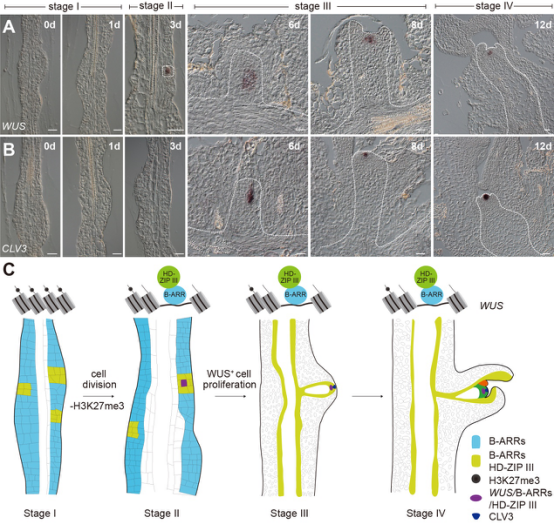
Under proper in vitro culture conditions, plant cells are totipotent and competent to regenerate from differentiated organs. This process is called de novo organogenesis. For six decades, scientists hold that cytokinin-rich medium induces shoot regeneration from callus cells. However, for such questions as how cytokinin directs shoot regeneration and where and when callus cells are regenerated into shoots, there is still no satisfactory answers.
Plant stem cells reside in stem cell niches, which produce signals that regulate the balance between self-renewal and the generation of daughter cells that differentiate into new tissues. In the model plant Arabidopsis, the homeodomain transcription factor WUSCHEL (WUS) is an organizer of the shoot apical meristem and acts as a non-cell-autonomous signal to maintain shoot stem cells.
Dr. WANG Jiawei and his colleagues at Shanghai Institute of Plant Physiology and Ecology of Chinese Academy of Sciences dissected the molecular framework for shoot regeneration. By using time-lapsed imaging, RNA in situ hybridization and genetic analyses, they found that WUS-expressing cell marks the shoot progenitor region and WUS is essential for de novo establishment of the shoot stem cell niche during shoot regeneration. WUS is directly regulated by B-type ARABIDOPSIS RESPONSE REGULATORs (ARRs), which act as the core signaling factors in cytokinin response pathway.
Interestingly, compared with other B-type ARRs regulated genes, WUS is activated by B-type ARRs in a spatio-temporal manner. WUS is induced after three days on cytokinin-rich medium. This time-dependent activation of WUS is associated with the level of repressive histone H3K27me3 modification at the WUS locus. A cytokinin-rich environment promotes the removal of the H3K27me3 at the WUS locus in a cell cycle-dependent manner.
After the removal of H3K27me3 marker, the WUS locus is competent for activation by B-type ARRs. The spatial activation of WUS is determined by microRNA165/6-regulated HD-ZIP III transcription factors, which are expressed in a small region within the callus. B-type ARRs bind to HD-ZIP III transcription factors and this transcriptional complex binds to the promoter of WUS and induces its expression.
Overall, this study revealed important insights into the molecular framework for cytokinin-directed shoot regeneration and may pave the way for increasing shoot regenerative capacity in crops. It was published in The Plant Cell.
The work is supported by the Natural Science Foundation of China, the State Key Basic Research Program of China, the National Postdoctoral Program for Innovative Talents, the Shanghai Outstanding Academic Leader Program, and the NKLPMG Key Research Program.

Figure: The B-Type ARR-HD-ZIP III Complex Spatially Activates WUS within the Callus (Image by Dr. WANG’ lab)

86-10-68597521 (day)
86-10-68597289 (night)

86-10-68511095 (day)
86-10-68512458 (night)

cas_en@cas.cn

52 Sanlihe Rd., Xicheng District,
Beijing, China (100864)

